1967 Dutch Grand Prix race report: Lotus back in business
Jim Clark is imperious in victory as the new Lotus-Ford combination comes good three races into the season
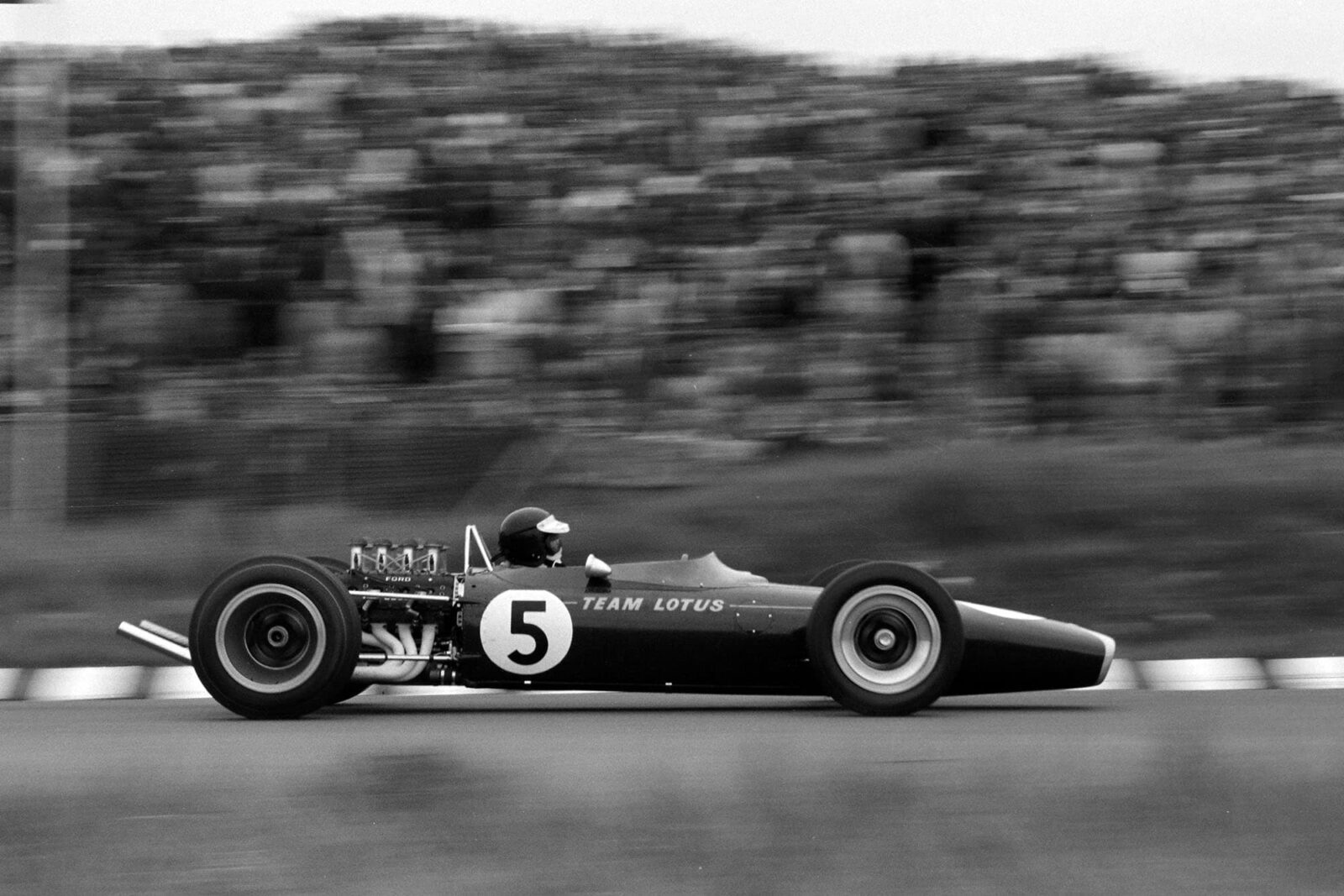
Jim Clark took his first victory of the season in the new Lotus 49
Motorsport Images
A very full and complete entry was received for the seventeenth Dutch Grand Prix held on the sandy Zandvoort circuit and it was notable for the number of brand-new Grand Prix cars that were ready for first practice; either brand-new models of existing designs, modified versions or entirely new designs. The Brabham team had four cars in all, a brand-new chassis with 1967 Repco engine and a Hewland FT200 gearbox, as used on Formula 2 cars; Brabham’s 1965 chassis that he used at Monaco, with a 1967 engine and heavyweight Hewland box, and the two 1966 Brabham-Repco V8s for Hulme.
The Scuderia Ferrari also had four cars, the long cockpit 1966 car with 1967 engine for Parkes, a 1967 car for Amon, a brand new 1967 car for Scarfiotti and one of the 1966 Italian GP cars as a spare.
Team Lotus were almost off the ground with pride, having two Lotus 49 cars with Cosworth 3-litre V8 engines, one being the car that Graham Hill had been testing in England and the other being brand-new, which Clark saw for the first time when he arrived on the morning of the first practice day.
Honda Racing had the two 12-cylinder cars for Surtees that he had at Monaco, both looking a bit ponderous and dated alongside all the sparkling new cars.
The BRM team had their two 1966/67 cars with H16-cylinder engines, and a brand-new one that was lighter and slimmer across the cockpit, Stewart having the choice of an old one and the new one, and Spence having the second old one.
Rindt and Rodriguez each had a Cooper-Maserati V12, but neither of them had the new 36-valve Maserati engine that appeared briefly at Monaco. Rindt’s car was the lighter 1967 car with Hewland gearbox and was using the new welded construction magnesium disc wheels and Rodriguez had one of last year’s cars.
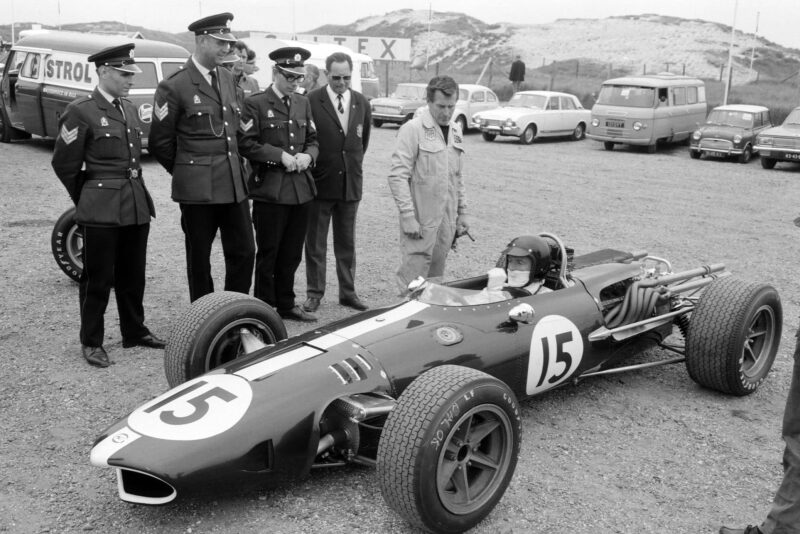
Gurney prepares to leave the paddock in the lone Eagle entry
Motorsport Images
Gurney was all alone with his Eagle team for Ginther had decided to withdraw from serious racing after trying all he knew and failing to qualify at Monaco and at Indianapolis, but his place in the team remained open should he change his mind at the last moment.
The team had three Eagle-Weslake V12 cars, the two from Monaco, though one of these was not assembled, and a brand-new car that was some 100lb lighter. The overall design had not been changed but great use of titanium and magnesium had been made, and this was the number one car that Gurney was intending to use.
“Gurney was all alone with his Eagle team for Ginther had decided to withdraw from serious racing after trying all he knew and failing to qualify at Monaco”
The rest of the entry was made up of single entries, these being McLaren with his neat little BRM V8-engined car, Irwin with Tim Parnell’s R3 Lotus-BRM V8, Anderson with his immaculate Brabham-Climax 4-cylinder and Siffert with the Walker team’s Cooper-Maserati, though it did not arrive until the second day of practice. Courage should have driven a second Parnell car, but it could not be got ready in time.
Qualifying
Practice took place all day on Friday, in three separate sessions, and again on Saturday afternoon, and during Friday the tempo seemed rather steady and cautious, with new cars being tried and everyone seeming to expect great things from the other teams.
Ferrari, BRM and Honda had all been to the circuit previous to official practice and all claimed spectacular fastest laps, but the known standard was the official lap record of 1min 30.6sec set up by Clark in 1965 with a 1 1/2-litre Lotus-Climax V8, a time which HuIme equalled last year, on an oily track, with a 1966 Brabham-Repco V8.
In practice last year, with a sister car to Hulme’s, Brabham made best time in 1min 28.1sec, so it was obvious that any time above 1min 30sec would mean that the driver was not really trying, or the car was hopeless.
Those drivers with brand-new cars obviously had to do some “bedding-in” of components or acclimatise themselves to the new cars, while others were able to press-on madly and set the pace.
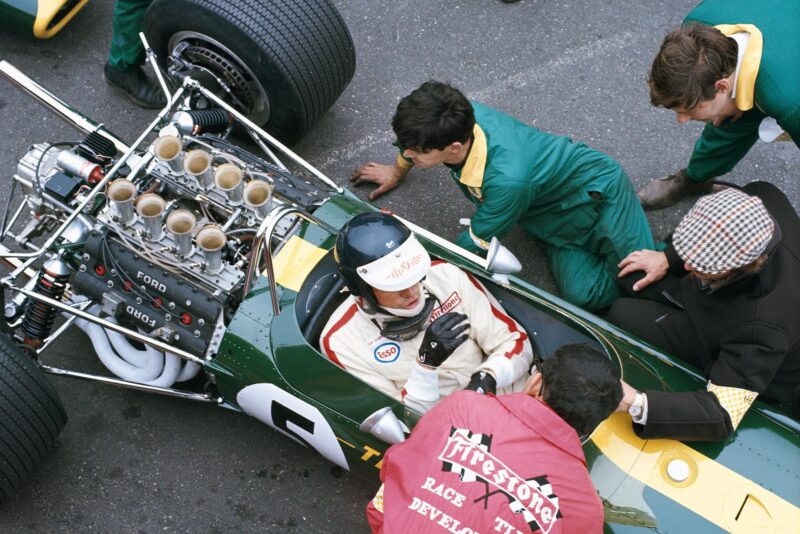
Lotus were running brand new Ford – Cosworth 3-litre engine’s in their Lotus 49
Motorsport Images
Brabham’s old chassis/new engine combination would not start, so he practised with the brand-new car, but he did not intend to race it and before the end of the day the recalcitrant engine was being removed from the old chassis, prior to being replaced.
Hill was having the pedals of the new Lotus fiddled about with to suit his feet and Clark was finding out about his new car. During the lunch break both cars had the gearbox changed, for similar ones with different ratios.
As it seemed certain that Ginther was not coming, his entry was given to the Ferrari team so that Scarfiotti could have a definite entry and many people cast covetous eyes on the spare Eagle-Weslake.
All day the weather was dull and overcast and somehow the atmosphere at the Zandvoort circuit always seems the same, so that Friday practice seemed to pass in a rather lugubrious fashion, even though there was a lot of quick motoring taking place as the accompanying table of practice times shows.
The Brabhams were quick and competitive as always, the Ferraris seemed to lack fire, the new Lotus-Cosworth V8s were beginning to show their true form, Surtees was satisfied with his Honda time as it had been done in full starting line trim, Gurney was in great form and very happy with his new lightweight car, Coopers were progressing without any fuss but BRM seemed a bit despondent, lacking in high-speed acceleration.
“Lotus began to stir things up towards the end of the afternoon, with the new 49 coming out on top on its first outing, much to the displeasure of a lot of people”
It was Gurney and Graham Hill who began to stir things up towards the end of the afternoon, with the new Lotus 49 coming out on top on its first public outing, much to the displeasure of a lot of people.
Clark was about to extend his Lotus and make a bid for fastest time when he was conscious of a feeling of instability. Nothing could be seen to be wrong, but he was convinced that something was not as it should he and the only likely thing seemed to the front wheel bearings, which had been brand-new and being taper rollers had probably “settled” and needed re-adjusting.
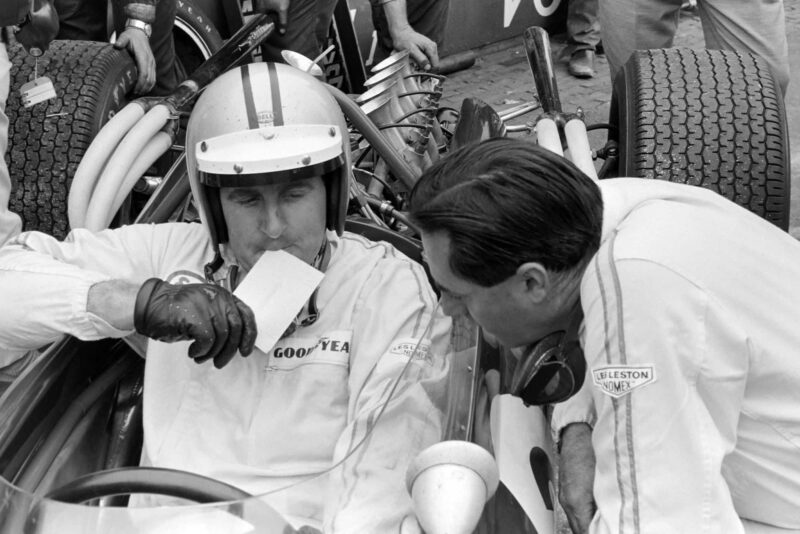
Denny Hulme and Jack Brabham, confer during qualifying
Motorsport Images
The Friday practice ended with Hill recording 1min 25.6sec, but Gurney was right behind with 1min 25.8sec and as both the Cosworth V8 and the Weslake V12 engines were new to Zandvoort, each with well over 400 bhp this was reasonable and natural as the “standards” from last year were set by low-powered engines. The performances of these two engines also made a lot of people much more conservative in their bhp estimates, even compared with their 1966 quotes.
Before the Saturday practice Clark’s suspension and steering was checked closely and slight play in the front wheel races seemed the only suspect thing, Gurney had a different engine fitted into his lightweight Eagle chassis, Brabham had the good 1967 engine taken from his new chassis and installed into his 1965 chassis, and the rest hoped that they could keep up with the Lotus and Eagle cars and searched around for excuses such as wrong tyres, wrong plugs, wrong springs etc, reluctant to admit that the two really powerful engines did have over 400bhp.
Clark had barely started to practise before the trouble he had been sensing, which Chapman could not locate, revealed itself forcibly; a ball-race in the right-rear hub broke up and split the hub carrier, and it was the first roughness that Clark had sensed the day before.
Until it was all taken apart there was a gloom in Team Lotus as it looked as though it was a design failure in the hub casting, but it proved to be a faulty race, so the gloom lifted. While a new hub assembly was prepared and fitted, which took most of the afternoon, Clark had to stand and watch Hill fend off any attacks on the fastest lap.
Brabham was very happy with his old chassis and was putting in some really fast motoring, equalling Hill’s best time, while Gurney was still not far behind. Hulme felt he was lacking in brakes and his discs certainly looked frail and puny compared with the Lotus and BRM discs.
Stewart was depressed by a lack of horsepower from the H16 BRM and too much bulk and weight, compared to the Lotus, and Gurney’s extra powerful Weslake engine was leaking oil from the rear main bearing.
The engine in Hill’s Lotus suddenly went rough and popped and banged, which brought gloom back to Team Lotus, this time on the Cosworth side, but it gave heart to the other teams who were getting despondent over the appearance of the Lotus. It was an electrical fault that was finally cured, even if no one was really certain from where it had originated, and as the sharp rasp of the V8 rang out loud and clear once more there were a lot of unhappy rivals.
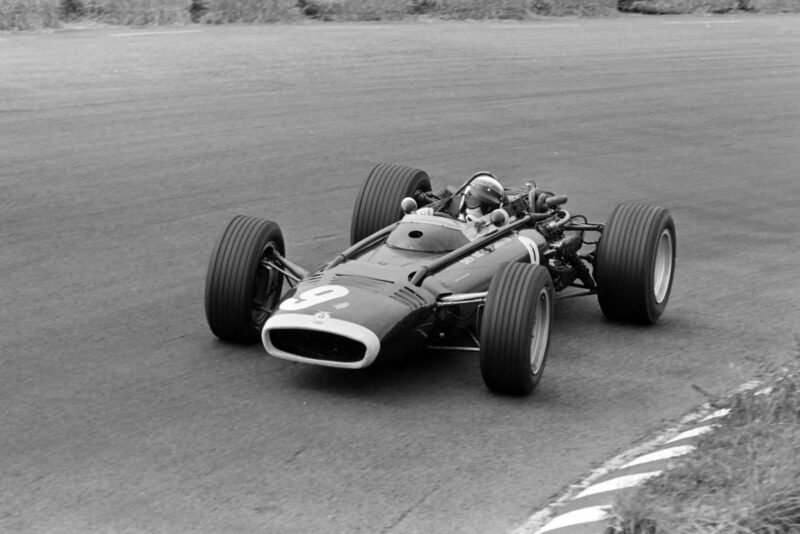
Jackie Stewart was struggling to find pace in his BRM
Motorsport Images
The leaking oil seal on the Weslake engine cured itself by some freak chance, so Gurney’s team were smiling happily once more, but the BRM team looked very depressed; Surtees was putting on a brave front and trying to look confident, the Ferrari team were working away hopefully, Brabham was actually smiling and enjoying the fact that his simple “old-fashioned” and unsophisticated car was on the front of the grid, and the Cooper team had quietly got themselves on the second row.
With practice nearly over there was a sudden rush of activity as everyone tried for a last final very quick lap, but the only two real challengers were Gurney and Hill and they battled against each other at around the 1min 25.3sec mark. Gurney stopped when he got down to 1min 25.1sec, feeling he had put Team Lotus in their place, but Hill went straight out and equalled this, doing two or three laps at the same pace.
His final lap as the chequered flag stopped practice was a real scorcher, and many people clocked it at 1min 25.0sec exactly, but the official time-keepers gave out 1min 24.6sec, so the Lotus fans hastily pocketed their stop-watches and cheered loudly.
Even the opposition did not protest, they all seemed rather bewildered. While this last-minute excitement had been taking place Clark’s car had been completed and he was able to get in a few laps, but with no opportunity to go really fast.
All seventeen entries had got below the rather artificial existing lap record and of the non-factory runners Irwin was particularly outstanding with 1min 27.5sec in the 2-litre BRM-engined Lotus, a time that put him ahead of McLaren and Scarfiotti, among others.
It was difficult to see why the two BRM works cars were slower than the Cooper-Maseratis and the front row of the grid had a trio of widely differing cars on it, as well as widely differing drivers. With practice over, Team Lotus were faced with all-night work checking all the rear hub assemblies as they did not want a repetition of Clark’s trouble.
Race
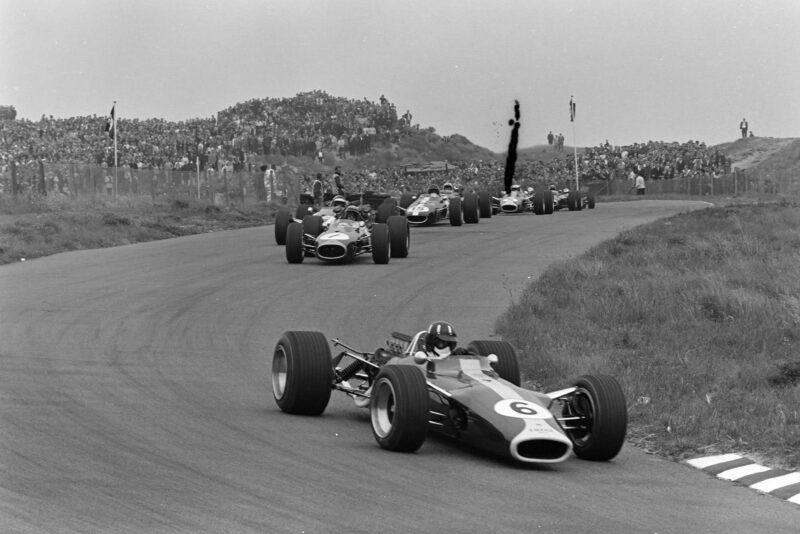
Hill took a nearly lead after starting from pole
Motorsport Images
The race was due to be run over 90 laps of the circuit, a distance of 377.37 kilometres (approx 235 miles) and the cars were allowed a “warm-up” lap on their way from the pits to the “dummy-grid” behind the starting line.
Brabham was driving his new centre-exhaust engine in his old chassis, Hulme had a 1966 car complete, Amon had a 1967 Ferrari with the latest centre-exhaust, 36-valve engine, as had Scarfiotti, while Parkes had this type of engine in his special long-cockpit 1966 car.
Clark had Lotus 49/2 and Hill had 49/1, Surtees had the newer of the two Hondas, Stewart and Spence were driving the earlier BRM H16-cylinder cars, with the external water pipes, Rindt and Rodriguez were unchanged from practice, and Gurney was using the lightweight Eagle. The remainder had no choice of cars, except that Irwin was having to use an early 1,930cc BRM V8 engine as his 2,070cc unit had broken a camshaft in the final practice.
“With 30 seconds to go an official was seen wandering amongst the cars, trying to persuade Rodriguez to move back a bit!”
When everyone had their engines running and 2:30pm was approaching the “dummy-grid” was cleared of extraneous people and the seventeen cars moved sedately forward towards the starting line, with Clark easing his way up into the second row.
With 30 seconds to go and the engine notes rising, an official was seen wandering amongst the cars, trying to persuade Rodriguez to move back a bit! As he turned to Rindt’s car the flag dropped and Hulme and Surtees were completely put off as they avoided the man, and they in turn baulked those behind them.
More by luck than judgment the man was not killed, and he joined the other race officials by the side of the track. The inevitable strong wind was blowing off the North Sea and the skies were grey, but everywhere was dry, at least for the opening lap.
Hill led from Brabham round the first corner, with Rindt, Gurney, Amon and Clark right behind. The Eagle had got away well for as it accelerated petrol sprayed out of the tank overflow system and went straight down the engine inlets, causing a rich mixture and a hesitant pick-up. Hulme’s Brabham seemed to be slopping petrol or oil as it cornered on the opening lap.
Hill had the new Lotus out in front, but there were five cars hot on its heels, Clark being at the end of this group as he was having to learn to drive the car and do some practice. He had virtually missed all the Saturday practice and in the light of Hill’s successful practice times, Clark’s car had been fitted with different rear springs and rear tyres, so it was all new to him.
On the second lap McLaren skidded off the track and damaged his car, but was unhurt himself, and this caused an official car to go round the circuit with a white flag on it, which made one realise that the Zandvoort circuit lacks any communication road system.
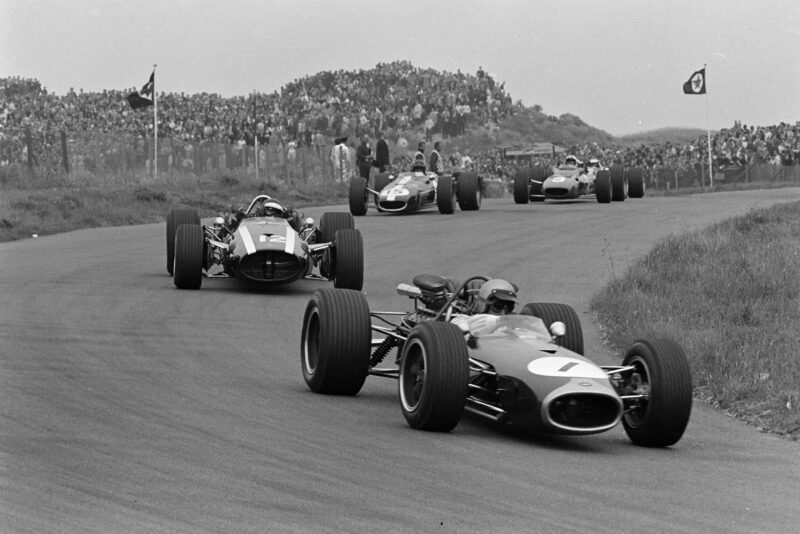
Brabham, in 2nd, leads Rindt, Gurney and Amon
Motorsport Images
Hill seemed to be in complete command, with Brabham trying vainly to keep up, while Gurney got past Rindt on lap 3 and Amon and Clark were close behind. Hulme made up ground very fast, after the baulking on the start line and by lap 4 was behind Clark, who had already passed Amon, while he had retaken third place from Gurney.
It was quite a busy bunch of cars at the front, led by Hill in the Lotus 49 and, though he had pulled out a 2 second lead over Brabham in five laps, the others were very much nose-to-tail, the order being Brabham, Rindt, Gurney, Clark, Hulme, Amon, the rest trailing along behind, with Surtees in a hopeless eleventh position.
The situation at the front was not presenting a very realistic picture, for Gurney’s Weslake engine was not running properly, the injection mixture not being right, Rindt was keeping pace mainly because he was happy on the slippery surface and others were not, Clark was still practising in effect, and Hulme was still suffering from the start line nonsense.
The pace looked fast but was in fact quite slow; the leaders lapping around 1min 33.0sec and on lap 7 Gurney was missing from the pack and could be seen heading for the pits. He made a brief stop to have an adjustment made to his fuel metering unit and then shot back into the race just as Surtees went by, but next round the Weslake engine sounded horrible and the car came to rest behind the pits with a broken fuel injection metering unit, and Gurney’s race was over.
The leading Lotus was not getting any further ahead of the Brabham in second place and the gap was still two seconds at ten laps, with Rindt (Cooper-Maserati), Clark (Lotus 49), Hulme (Brabham) and Amon (Ferrari) following. Then at intervals came Rodriguez (Cooper-Maserati), Stewart (BRM), Parkes (Ferrari), Surtees (Honda), Scarfiotti (Ferrari), Spence (BRM) and Irwin (Lotus-BRM), while Anderson had been lapped and Siffert was in the pits having his suspension looked at as his Cooper-Maserati was feeling odd.
“Next time round there was consternation in the Lotus pit as Brabham was leading with no sign of Hill”
Next time round there was consternation in the Lotus pit as Brabham was leading, followed by Rindt, Clark, Hulme, Amon, and all the others, with no sign of Hill. By the time the leaders were round again. Hill’s car could be seen coasting along the straight with a dead engine and he pushed it the last few yards in the pit area.
While the race went on a crowd huddled round the Cosworth V8 engine, and after a time it gave one short flat-sounding “blurp” and then the Lotus was wheeled away to the paddock. Teeth had broken off one of the camshaft driving gears and, before the engine died, Hill had been conscious of an obtrusive ticking noise. For five short laps Brabham held the lead, but it was clear that Clark had done sufficient practice and was now going to start motor racing.
On lap 15 he took second place from Rindt, on lap 16 he took the lead from Brabham and then just motored relentlessly on into the distance. This, coincided with the track drying right out and as fast as Clark went ahead, Rindt dropped back, as he couldn’t seem to steer the car properly on a dry track.
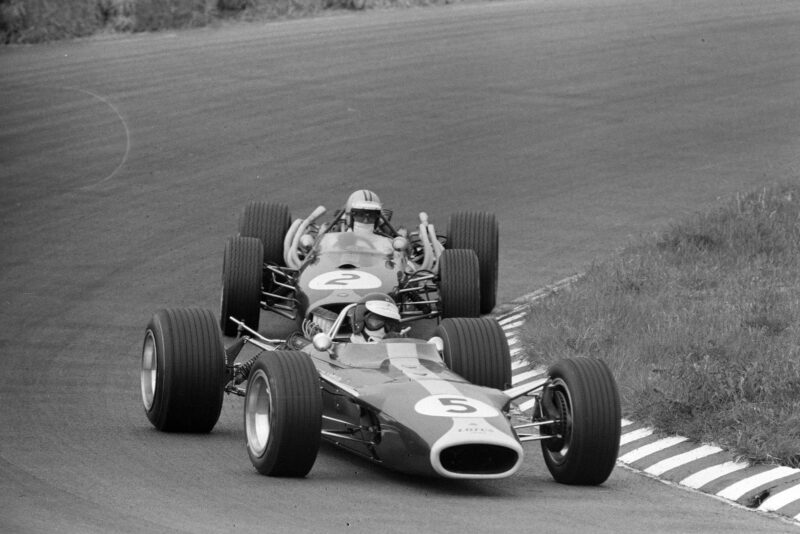
Clark hunted down (and passed) Hulme
Motorsport Images
By 20 laps Clark had pulled out a 2 second lead on Brabham, but it did not stop there, the gap got wider and wider and it was not long before it could be measured at a second a lap. Without much effort the brand-new Lotus-Cosworth V8 was lapping at just over 1min 28sec a lap, there being no need to go any faster in order to leave the rest of the field behind.
Although none of the positions changed it was not for lack of trying on the part of the drivers, for Amon in fourth place, was pressing hard on Hulme all the time, but had neither the surplus of power nor experience to overcome his fellow New Zealander.
Rindt gradually slowed until he was caught by Stewart, even though the excitable commentator seemed to think that it was Stewart who was speeding up, and at the back of the field of those who had not been lapped by the flying Clark, there was Scarfiotti keeping up with an unhappy-looking Surtees in the cumbersome-looking Honda. These two appeared to be gaining on Rodriguez, but in actual fact the Cooper-Maserati was slowing and it finally came to rest behind the pits with a broken gearbox.
This was on lap 40 and on the next lap Rindt took his Cooper-Maserati into the pits and retired as he could not cope with the way it was handling, there obviously being something wrong, but nothing visible so for want of an explanation the ZF differential unit was blamed.
By now Irwin and Spence had been lapped by Clark and Scarfiotti was about to be, Anderson was running smoothly and steadily and Siffert was following. On lap 44 the devastating Clark in the new Lotus 49 lapped the mighty Honda and was eleven seconds ahead of Brabham and still gaining, while Hulme in third place was still being hounded by Amon in the first of the Ferraris.
A very poor fifth was Stewart ahead of Parkes, but on lap 45 the 16-cylinder BRM was lacking effective front brakes and it stopped at the pits. The brake fluid had gone from the reservoir and most of it seemed to be down among the pedals, so the container was topped up and Stewart rejoined the race. He only did six more laps before it had all gone again, so he stopped once more and this time retired.
The all-conquering drive by Clark in the new Lotus continued unabated and unchallenged, his driving being smooth and effortless, while the Cosworth V8 engine never missed a beat. Parkes was lapped in due course and Irwin and Anderson were lapped yet again and by lap 61 even Brabham had lapped the Honda.
Amon was not giving up the battle and was waiting for any opening that Hulme might inadvertently give him, but the Monaco winner was not making any mistakes and was certainly not going to be worn down by the Ferrari driver. This fruitless pursuit for third place tended to overshadow the beautiful performance by Clark way out ahead of everybody and driving with such ease and style, even though his clutch mechanism was not operating smoothly.

Amon caught Hulme but couldn’t find a way past
Motorsport Images
Now and again Amon would get his Ferrari alongside Hulme’s Brabham, but there was never any question of getting it in front, for Hulme always made sure he was in the right place at the right time, thus preventing any “diving into the corner” or “chopping” tactics by his young adversary.
At the back of the field Spence was having a bad time in the remaining 16-cylinder BRM, having to hold the gear lever in place all the time, and at one point he got his hands crossed and spun the BRM, this letting Irwin get by in the Lotus-BRM V8 which he was driving very neatly and smoothly, auguring well for better cars in the future.
“The Honda was running worse and worse and Surtees finally gave up after 73 laps”
The Honda was running worse and worse and Surtees finally gave up after 73 laps, having had a mild spin due to the throttle slides sticking, and muttered about differential gears that were not working properly. This retirement saved the Honda the embarrassment of being lapped for a second time by the green and yellow Lotus in its record-breaking flight. With fifteen laps still to run the situation was that Clark was completely unchallenged, Brabham was holding second place but easing off, which meant that the Hulme/Amon duel was gaining on him.
These four were the only ones on the same lap, and one lap down came Parkes and Scarfiotti, the Ferrari team still being complete as was the Brabham team. Two laps behind were Spence and Irwin and still running, but a long way behind were Anderson and Siffert.
Clearly if no one ran into trouble this was how the race was going to end and it was an anxious Team Lotus pit crew that ticked off the laps, knowing that Hill’s Cosworth engine had developed a fault, and equally it was a thankful Clark that was holding first place without being challenged, for he had no idea what had happened to his team-mate’s car, just hoping that whatever it was it would not happen to his car.
With seven laps to go the Hulme/Amon pursuit race caught up and lapped Parkes and the Ferrari engineer did his best to cause some fumbling in the hope that young Amon might get by, but it takes more than two Ferraris to ruffle the swarthy Hulme.
“Clark having showed once more his true ability as a Grand Prix driver”
The gap between Brabham and Hulme was down to six seconds, as Australian Jack was taking it easy, realising he could do nothing about Clark, and suddenly the Brabham pit realised that Brabham was not aware of the fact that Hulme was being hotly pursued by Amon.
They had only been signalling that Hulme was many seconds behind, so they came out with a signal that said: “Hulme and Amon – 6sec” whereupon Brabham quickly opened the gap to 10 seconds and so the race finished, with a jubilant Team Lotus, which included Chapman, Duckworth, Lotus engineers and mechanics unbelievably happy with this outstanding victory by a brand-new design and Clark having showed once more his true ability as a Grand Prix driver. Brabham was well satisfied with second and third places, and Ferrari must realise that all they need is one of the “top five” in the team to gain success.
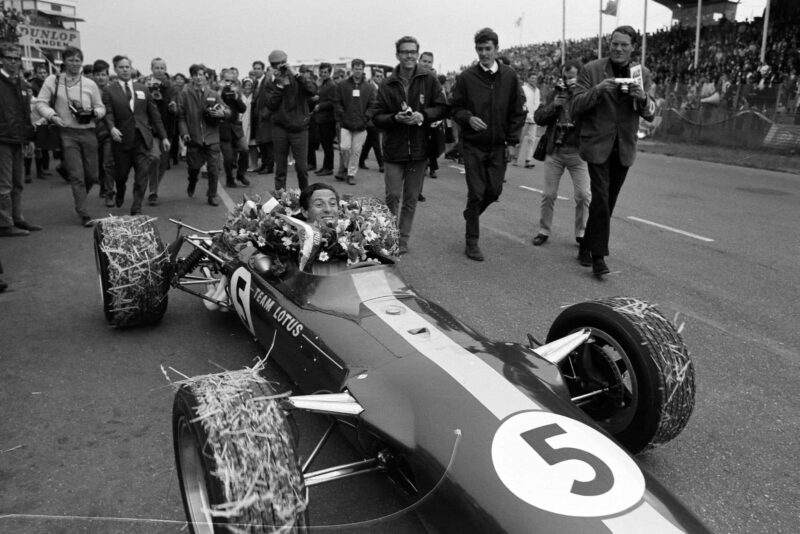
Clark is clearly pleased with his first win of the season
Motorsport Images
Zandvoort in the Zand
- Ford (England) top brass were present and must have felt that it was money well spent when they saw the results achieved by Team Lotus.
- Honda do not seem to learn very fast, Surtees retired with a “sticking throttle slide” in the Race of Champions in April. It was the same story at Zandvoort.
- The more careful teams wrapped all the suspension and steering joints in cellophane and sticky tape, to keep out the sand that impregnates the circuit.
- Funny how drivers who are out-driven by a superior car or driver always have very good reasons for not winning. Seldom hear the winning driver making excuses for winning.
- Brabham blamed his tyres for the reason he could not stay with Clark; his tiredness made him think he had a slow puncture, which was complete imagination.
- It was a relief when Stewart retired. The race commentator sounded like Stewart’s PRO man, and the little Scot was not even leading the race.
- When is Brahham going to give Anderson one of last year’s Repco V8 engines to put in his nicely prepared car. Some thought that Gurney, with three cars and engines and Surtees with two cars and engines were just plain greedy.
- Maurice Gatsonides, the ex-rally driver, timed the cars with his Gatsometer and got Hill and Gurney fastest at 165 m.p.h. and Anderson slowest at 148mph. A pity he has developed this instrument on racing cars and sold it to the police to trap unwary motorists.
- Someone thought they saw the new German Chancellor arriving in a Mercedes-Benz 600 limousine. It was a very imposing car.
Notes on the cars at Zandvoort
The latest Formula 1 Brabham chassis that appeared for first practice was BT24-1, still being a multi-tubular space frame, but the pedals were pivoted on a lower cross-member instead of being “pendant” from an upper member.
An FT200 Formula 2 Hewland gearbox was being tried experimentally with a view to weight saving as it is some 30lb lighter than the normal Formula 1 Hewland gearbox. A small plate on the instrument panel of this new car read “Maximum speed not to exceed 170mph”! Jolly Jack some people call him, others call him Black Jack.
Whichever way it is he has to be respected and the Brabham cars are rather like the 250F Maserati of 1957. They are not very clever or sophisticated, but they are honest and forgiving and the drivers can take diabolical liberties with them without getting into difficulties.
Gurney’s AAR Eagle chassis No. 104 was the lightweight one, such things as wishbones, radius rods, pedals and pedal mountings were all made of titanium, a very expensive material that can replace steel as far as strength is concerned yet is much lighter. Welding titanium is no easy matter and skilled men in the racing game whistled with admiration at the workmanship and welding on the new Eagle chassis.
The 1967 Ferrari chassis, to take the centre-exhaust 36-valve engines have higher side pontoons alongside the engine, giving more space for fuel bags. The 1966 type chassis that Parkes still uses has lower sills alongside the engine as originally, with the 24-valve and with the Monza 36-valve engines, the exhausts were on the outside of the heads and passed over the sills before curving rearwards. With the 36-valve centre-exhaust engine installed, the 1966 chassis has side panels attached by Dzuz fasteners to fill up the space. The spare car which Scarfiotti used briefly in practice on Saturday, had a Monza type 36-valve engine with the side exhausts over the chassis sills. This car was 0011, Parkes had 0012, Amon had 0003 and for the race Scarfiotti had 0005.
The “lighter, but not lightweight” BRM H16 was much slimmer across the cockpit, had internal water piping, a roll-cage designed into the cockpit structure and different shaped front wishbone rocker-arms, while the fabricated sheet steel structure that carries the revised rear suspension was lighter and simpler.
In the interests of reliability the H16-cylinder engines have been detuned to give about 375bhp and Spence has now completed the Monaco and Zandvoort races. If they can keep this reliability and return to the original 420bhp they could be competitive, as the handling and manners are satisfactory.
The two Lotus-Cosworth V8 cars were 49/1 and 49/2, number one being the first car to he completed and tested by Graham Hill, which appeared in all the publicity pictures, and number two being untried until it ran at Zandvoort. Team Lotus had no spare engine with them but there was the nucleus of one back at Northampton and in the transporter was old R11, the type 33 with BRM V8 engine in it, just in case of complete and utter failure. The other old Type 33 was badly bent at Monaco.
Mallory Park – Formula Two (May 14th)
The first of several Formula Two races to have its entry reduced by Indianapolis was run at the small Leicestershire track of Mallory Park on May 14th. However, there were sufficient entries to run the race in two heats and a final and all were held in appalling conditions.
The first heat comprised most of the faster competitors and was won by the Belgian Ickx in Ken Tyrrell’s Matra-Cosworth from Surtees in his Lola-Cosworth, with Rees third in the Winkelmann Brabham-Cosworth. The second heat was won by Lambert (Brabham-Cosworth), from Formula Three driver Gaydon in a borrowed Brabham-Ford twin-cam and Raby in another Brabham-Ford twin-cam.
The 75-lap, 97 1/2-mile final was significant for the number of drivers who crashed or spun at Gerard’s Bend. Ickx led initially but soon had the first of four spins at the corner, leaving Surtees to win by a total of three and a half laps. Gardner drove the lone works Brabham to second place ahead of McLaren, Ickx and Rollinson (Cooper-Cosworth).
Iliffe Books Ltd. have now issued the 1967 edition of that specification reference work to beat all such books, the “World Car Catalogue.” It runs to 672 pages, 10 1/2in. x 9in, almost all of them carrying a couple of pictures on fine art paper, and it is a car directory highly praised by many export companies. Compiled by the AC of Italy, the British edition costs 63s, or 66s 9d post free from Iliffe Books Ltd, Dorset House, Stamford Street, London, SE1.
